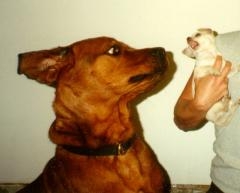Body Language
Dr. Ian Dunbar -http://www.dogstardaily.com
Another great article by Dr. Dunbar to help you learn more about your own dog. Do visit the Dog Star Daily website when you get a chance. It is full of interesting and informative articles all reliable and written by experts in their respective fields
Dr. Ian Dunbar -http://www.dogstardaily.com
Another great article by Dr. Dunbar to help you learn more about your own dog. Do visit the Dog Star Daily website when you get a chance. It is full of interesting and informative articles all reliable and written by experts in their respective fields
c

Dog Star Daily
..Even though few of us are fluent in the many dog languages, most of us can tell the difference between a friendly dog and an unfriendly one. The dog seems to get the message across with very little difficulty. It is as easy to sense the aura of a confident, relaxed and easygoing dog as it is to observe specific behaviors and body postures. Such dogs fairly exude warmth and friendliness — head held high with a big doggy laugh, gamboling gait and curved tail wagging the dog's rump. Similarly, one can literally feel the tension emanating from a dog that is not friendly — head lowered, ears flattened, piercing stare, teeth bared and growling, pilo-erection along the back, stiff-legged, and tail held high, straight, stiff and usually vibrating.
It is hard to live with a dog for even a few days without learning a wide vocabulary of his body language. Most owners have a fairly firm grounding on how a dog acts when he is happy, confident, friendly, deferential, fearful, or aggressive. In fact, most dog owners have successfully compiled a comprehensive and descriptive doggy dictionary of body language covering much of the dog's behavior repertoire, with sound interpretations for each posture.
Doggy Feelings
Most people's interest in dog behavior and body language focuses on their desire to gain insight into the dog's emotions, feelings and preferences: To get a better idea of how the dog is feeling and what she would like to do. Most owners care for their dogs and they care about how they are feeling. They want to know whether their dogs are contented, or if they are upset. It adds warmth to the soul to empathize with another individual and especially so with another species. Also, it is just plain fascinating and heart-warming to watch a dog attempt to communicate with her eyes, furrowed brow and maybe a few ear twitches — that for example, she would like to have dinner earlier on Sundays, that she would like to go outside to take a leak, that she has lost squeaky hedgehog under the bed, or perhaps that she would like to be asked to snuggle on the couch. These are the delights of sharing life with a dog.
But, "Beware of heartless them... given the scalpel they would dissect a kiss!" For some, learning about dog language has little if anything to do with interpreting the dog's feelings and emotions. Instead, the interest in body language is for predicting bad behavior and devising different means of punishment. Whether the dog is upset is of secondary significance; the prime concerns appear to be whether or not the dog will bite and how to punish it in some ersatz wolfy way. As if this were not a sufficiently negative outlook with overtones of schadenfreude, ironically, the continued manhandling and bullying (abusive human body language) is the major reason why the dog was upset and felt like biting in the first place.
A rudimentary and utilitarian interest in body language to predict whether or not the dog will bite certainly makes sense for those professions who deal with numerous adult dogs of unknown disposition. However, the predictive value of body language is not as reliable as most think, largely because many body cues may have a variety of meanings and because fearful, rambunctious and uneducated dogs are more likely to bite than those that are aggressive. In fact, most growly dogs don't bite, whereas some dogs appear to bite without warning.
Ambiguous Behavior
It is not always true that a dog's actions necessarily mirror his intentions. Whereas we may easily observe and quantify a dog's behavior, we can only hazard a guess as to his feelings and intentions. This is not to say that dogs are intentionally deceitful, double-dealing or deceptive. Duplicity is after all a quintessential human foible. Rather, many dog body postures and vocalizations simply have a variety of meanings. For example, a growl may be a threat, or it may signify frustration, fear, lack of confidence, or learned helplessness. Alternatively, a growl may be an invitation to play, or it may be a learned communication that has very little to do with underlying emotions. Some dogs growl as a solicitation to play, some growl as a request to be etted and some will growl if you try to stop petting them. Obviously, the dog's growling quickly becomes a learned behavior because it has been invariably (albeit unintentionally) reinforced by the owner playing or petting the dog. Growling is one of the most misunderstood vocalizations in the doggy dictionary, especially in some breeds, which seem to growl, or “talk” about every conceivable topic including the weather.
On the other hand, characteristically friendly behaviors may have alternative unfriendly interpretations. A dog may bare her teeth as a submissive grin, or as a threat. A dog may paw you as a sign of friendly appeasement and deference in greeting, or she may pin you with straightened forearms as a threat. A dog may sidle up to you for company, or as a spatial ranking maneuver. A dog may bring you a present, or it may proffer a “gift” as a test — to see if you dare try to take it away. And all of us know a wagging tail signifies a happy friendly dog — right? Well certainly a high frequency, large amplitude wag augurs well for a happy social encounter, but there are several different types of tail wag. For instance, it is not uncommon for a dog to wag his tail furiously when barking and lunging at another dog. Similarly, a large amplitude, slow frequency cat-like tail swish means the dog reeeeally doesn't like you and a high frequency, small amplitude vibration at the tip of the dog's perpendicularly held tail, generally signals the animal is extremely tense and stressed and about to react.
Stressed?
Other signs of stress may also have alternative simpler explanations. For instance, whereas excessive scratching and urine marking are usually signs of low-level stress, itchiness might be caused by a flea and frequent urination may follow a good sniff and frolic with the female dog next door. When a dog yawns, he may be tired. More likely though, he is mildly stressed. Similarly, baulking, slumping down, and rolling-over may suggest the dog is tired, or it may reflect increasing levels of underlying stress in training, stemming from the dog's confusion and the owner pushing him too far too fast. The dog acts helpless and eventually the owner stops bugging him and leaves him in peace, thus reinforcing the dog's act of helplessness. The dog may now learn to act helpless as a ploy to stop training at other times. Some dogs even growl out of learned helplessness. The poor dog just wants the bullying to stop and usually growling does the job. Sometimes though, the growling is erroneously perceived as stubbornness and dominance and so, the bullying increases until eventually and inevitably, the dog growls for real!
The interpretation of ambiguous cues can be difficult at times and often depends on context. Sometimes, quite subtle atmosphere cues help provide the answer. For example, a protruding tongue, a brief paw raise or even an obvious playbow would all signify the playful intentions of subsequent behaviors, such as growling and chasing.
If you miss the interpretive atmosphere cue, ask the dog “how he is feeling” by instructing him to come, sit, lie down, and rollover. If the dog does not come, if he freezes, baulks, cowers, or runs away, usually you are in trouble. But if the dog comes quickly when requested, he is advertising that he is friendly and prosocial. And of course, rolling-over is the penultimate sign of doggy deference. What more could we ask for? Also, worthy of note, he is demonstrating compliance. In fact, he is being willingly and happily compliant. A prompt response by the dog is good evidence that the owner is in control.
When a dog promptly (and happily) comes, sits, lies down, and rolls over when requested, the dog is demonstrating compliance and the owner is in control. This is a simple but revealing test if ever you are confused concerning your dog’s feelings or emotions. The above procedure also helps rebuild confidence in a dog that is upset. If the dog concentrates on responding promptly to all four requests, most likely he will stop growling before completion. Welcome to the wondrous magic of counter-conditioning.
With ambiguous cues, as with any doggy behavior, the important questions are: 1. Do you think your dog likes you? (Or, do you have an adversarial relationship?) And 2. Can you control the dog's behavior? For example, if a growly dog will shush and settle down on request, it is unlikely the dog is growling because he is aggressive.
Growly dogs
What if you have a lot of difficulty stopping the dog from growling? Are we dealing with a dreaded dominant dog? An aggressive cur? An alpha leader of the pack — planning to take over the family today and tomorrow, the world? Most likely not. Characteristically, growly and blustery dogs are middle-ranking males, who have limited experience and are insecure of their social standing and so, usually resort to bluff and protracted threats. (Not too dissimilar from people really.) Often the dog may growl incessantly to add major emphasis to a minor point. Most overtly aggressive dogs are all bark and no bite. "If you really have it, you don't need to flaunt it." Indeed, a true top dog is a rather cool and relaxed customer, who very rarely resorts to lengthy threats, let alone prolonged blustery bluffs — he doesn’t need to. Instead the threat is subtle and the follow up is immediate, short, and sharp.
The Quiet Type
Basically, most dogs have two bona fide reasons to bite: 1. Because they are dogs and that's what dogs do and 2. Because by and large, people are not very nice to them.
When dogs are upset or frightened, they don’t call a lawyer, or write a letter of complaint, they simply growl and bite. Ironically, in the rare instances when a (usually) fearful dog does follow through, he is often accused of unpredictably biting without provocation — without warning and without reason. In reality though, there were most certainly many good reasons for the dog to bite and he most certainly gave numerous warnings, even though the warnings may have been too subtle for most human observers.
Many dogs do, however, bite with little threat or warning, but this has very little to do with aggressiveness. On the contrary, the vast majority of dogs bite because they are fearful, frightened, unsocialized, and/or lack confidence. A bite might be expected if the dog were cringing, or snapping and lunging, but often the dog's standoffish demeanor is the only overt warning. And of course an unsocialized sleeping dog may bite if disturbed or frightened. Other dogs bite due to uncontrolled rambunctiousness. The dog may be in a decidedly happy frame of mind and is only doing what he did as a puppy, because no one taught the puppydog that unsolicited playbiting was unacceptable. Now the adolescent dog's playfulness is out of control and he hurts people. Thus a dog may bite with nary a growl. Indeed, the biting dog may be playfully wagging his tail!
There is an additional, quite insidious reason for a dog to bite without warning. Originally the dog would growl whenever he was upset. Although people heard the growl, they did not listen to what the dog was saying. The dog was upset but no one paid heed. Instead they punished the dog for growling. The dog now had two reasons to be upset, the original reason and the fact his owner is angrily bullying him — and so, the dog growled more. Unfortunately, the level of punishment was increased until it effectively inhibited the dog from growling. The dog no longer growled, but he was still upset, in fact, very upset. Now we have the equivalent of a time bomb without the tick. The dog is doubly upset but no longer shows it, because the owner systematically punished him for trying to communicate his feelings. By all means instruct a growling dog to shush but ALWAYS investigate and attempt to resolve the underlying cause.
The Quest for The (Un)Natural Punishment
Some misguided folks' interest in dog body language is limited to their quest to devise socalled “natural” ways to punish a dog. For example, to employ stare downs, scruff shakes, and alpha rollovers in an attempt to punish a dog in the same manner a top dog might reprimand a lower-ranking individual, or a she-wolf might chastise a cub. This approach is really too silly for words and an insult to the dog's intelligence. Nonetheless, such tabloid,
pseudo-science obvious appeals to some types, even though it may be a little thin on logic and scientific backing, and often, next to ineffective. And all of this rigmarole takes place under the guise of training. If it were not so abusive, it would be laughable.
The very concept that one has to manhandle a dog to gain his respect is just plain wrong — and as potentially dangerous as it is ludicrous. What if a child tried to manhandle a large dog? Should the poor dog object, no doubt he would be punished, surrendered to a shelter and likely euthanized. Why assume such an adversarial and combative relationship with an animal? Why treat our best friend like our worst enemy?
Surely, any punishment is an indication the dog has not yet been trained effectively, otherwise the dog would no longer misbehave and therefore no longer require punishing. Any punishment should prompt the owner/trainer to go back to step one and retrain the dog, preferably using different methods (since the previous techniques obviously did not work that well). Repeated punishments, however, are a blatant advertisement of a trainer's incompetence. The punishment-oriented “training” method has obviously not worked at all because the dog continues to misbehave, (or rather, to act in a manner which it has not yet been taught is
unacceptable). I think we are talking about a bad teacher here, not a bad dog.
And just what is it with these campy she-wolf impersonations? Some people are just itching to grab a pup by the scruff and roll her over and pin her to the ground. Under the guise of training? No. It's just an excuse to bully and frighten puppies and dogs under the misassumption that this is how dogs do it in the wild. This borders on full-blown lycanthropy, whereby the “trainer” feels he/she has been transformed into a wolf and so administers wolfy punishments. Soon these people will go the whole hog (or dog) and resort to dressing up in doggy suits (with moveable ears and waggy tails) to muzzle-bite puppies on gaudy television shows — Trainer Gladiator, Owners Gone Wild or Puppy Survivor. Or perhaps, they will even resort to urine marking in their futile quest for virtual-reality, olfactory communion. I am sure no dog in his right mind is even remotely duped into believing that his owner is a wolf, a top dog, or a postpartum bitch. Too silly for words.
The vital flaw in this lycanthopic fiasco is that when trainers cite the supposed dominant behavior of alpha wolves, top dogs and bitches, they actually give an accurate description of insecure, middle-ranking males — the annoying blustering of little furry sacs of testosterone. They have utterly overlooked the true subtlety of dog behavior and body language and completely failed to notice how a true top dog can put down a lower-ranking transgressor at fifty paces with a mere glance. A true top dog uses mental control (not physical domination) to prompt respect and active appeasement in lower-ranking individuals. Perhaps we should learn
from this.
Human Body Language
With all the abusive silliness in “training,” no wonder many dogs become upset. In fact, I am continually amazed by the unreserved patience and tolerance of most pet dogs. Of course the dog feels ill at ease with the incessant mindless, physical manhandling, bullying, and other grotesque human body language. All too often, the so-called “treatment” is the cause . In reality, we will never know for sure what a dog is thinking or how she feels, simply from observing her behavior. Instead, the interpretation of the dog's feelings has to transcend mere clinical and objective observation and instead, we have to feel how the dog feels. And surely it shouldn't take the brains of Einstein to realize, frightening and bullying dogs probably doesn't make them feel very good. Why on earth don't we just respect a dog as a dog and train him as if we are both human and humane? Dog training is hardy rocket science. Training comprises teaching dogs ESL (English as a Second Language) — teaching dogs human words for doggy behaviors and actions, so that they understand how we would like them to act. Let’s use our supposedly superior intellect to simply teach dogs what we would like them to do and then, to want to do what we would like them to do.
Training is all about communication, motivation, and building a good relationship. Training is really quite simple and a lot of fun. Most important, children must be taught how to gain a dog's respect, so let's make sure that we use training methods that are suitable for all family members — user-friendly and dog-friendly techniques to create people-friendly dogs. ©2006 Ian Dunbar
|
Does your puppy need prozac?
Medication for behavioural issues is becoming more common - find out which medications would be used and why. |
This is why a dog never dies
A beautiful short article which will really resonate with those of us that have dogs that have died. |
Various eye infections
A great article which shows us all the different eye infections and natural ways to help to overcome them. |
This article is copyrighted and remains the property of the author. Individuals are welcome to print or copy same for their own use in furthering their knowledge of dogs. However, no reproductions or alterations/variations are allowed without the express written consent of the author.




